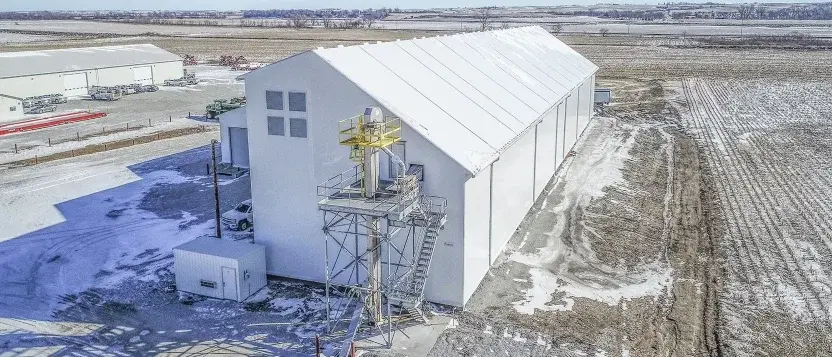Designing for Durability: How to Ensure a Long Lifespan for Your Building

Commercial building design is a significant investment. The key to maximizing return on investment (ROI) is designing for durability—creating a structure that lasts longer and requires minimal maintenance.
For commercial architects and in-house designers, fabric building construction offers a versatile, practical solution that delivers both outstanding durability and aesthetic appeal.
Pillars of Building Durability
Durability isn't a one-size-fits-all concept. It varies based on the building's intended use, but three critical elements consistently determine a structure's longevity:
- Foundation
- A well-engineered foundation is non-negotiable. While some sites might seem suitable for minimal ground preparation, a robust foundation is essential for reliable performance and long-term structural integrity.
- Framework
- Every structure must be engineered for point-loads and environmental loads, as well as local building codes and regulations. Your commercial building may have to endure heavy rain or snow, extreme temperatures, or harsh events–such as hurricanes, hailstorms, or earthquakes. The environment itself may also be corrosive–salty marine air outside, or products such as salt or fertilizer stored inside.
- Cladding
- Cladding keeps weather out and helps define the indoor working environment. It directly affects your building’s appearance, especially if it fades, peels, or rusts from UV and weather exposure. Cladding also affects fire resistance.
Designing for Durability
Material selection can make a dramatic difference in your commercial building’s ultimate durability. Framing and cladding both play critical roles in structure design.
Framing
Traditional metal frames are vulnerable to moisture and chemicals, which cause corrosion and promote mold and mildew. Hot dip galvanizing helps slow the process, but it can’t prevent the need for regular, expensive maintenance.
Conversely, Legacy Building Solutions' 3-plate steel I-beam construction offers exceptional sturdiness with Epoxxi-Shield™ epoxy coatings, providing superior corrosion protection. It also allows for long, clear spans without support columns that can limit interior configuration and workflow.
Every Legacy tension fabric building is designed to meet local building codes, the International Building Code (IBC), National Institute of Standards and Technology (NIST) standards, and National Fire Protection Association (NFPA) standards. Our structures are reliably sturdy in all weather, anywhere, including High-Velocity Hurricane Zones.
Cladding
When fasteners and screws are used to attach metal cladding, it can provide thousands of opportunities for moisture to enter the building. Metal can also suffer from extreme thermal expansion and contraction, which can create moisture leaks over time. Legacy’s unique ExxoTec™ tension fabric, meanwhile, seamlessly attaches to the framework in panels that can be replaced individually as needed.
Proper fabric tensioning is crucial to structural longevity. In many fabric buildings, the cladding is one enormous monocover, which tends to billow or sag over time.
- Monocovers are typically attached only at the sides and ends, using ratchets and straps that pull on a tension tube secured at the building’s base plate. This leaves the fabric on the roof of the building resting on top of the frames, without being secured.
- Without proper attachments, wind can lift the fabric wherever it isn’t attached to the truss or frame. Over time, repeated motions can wear down the fabric, ultimately reducing its lifespan.
Legacy’s in-house installation crews apply proper tensioning and paneling techniques to reduce the likelihood of billowing later.
- In a paneled attached system, wind can freely flow over the top of the building. Although the wind may slightly pull the panel, the system is securely fixed to the entire frame, resulting in minimal wear and tear. As a result, both the fabric and the building last longer.
Legacy fabric also provides unique roof benefits, especially in uninsulated buildings. We can offer more natural daylight and more efficient temperature control to save energy costs and provide a more pleasant working environment.
Every Detail Makes a Difference
Durability isn't just about choosing materials—it's about creating a holistic solution that performs consistently, efficiently, and economically over decades.
Usage requirements, location, and other conditions all vary, so “standard” commercial building design or components may not always make sense, functionally or economically.
Legacy fabric buildings are original from the ground up. Every detail is designed, engineered, and manufactured to match your operational needs and specs. Our own installation pros perform the final work on-site to ensure everything is just right. 
Subscribe to our Blog
Recent Posts
- Climate Resilience in Commercial Construction: Why Traditional Methods May Not Be Enough
- Speed and Quality: The Role of Hybrid Building Materials
- Beyond the Bleachers: Designing Visually Striking Sports Facilities
- Why Architects Prefer Hybrid Steel Over PEMBs & Traditional Builds
- Building Innovations and Trends in the Mining Industry
